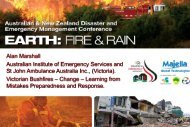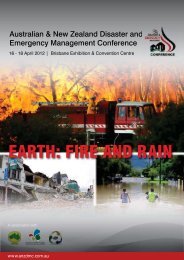Book of Abstracts 2013 - Australian and New Zealand Disaster ...
Book of Abstracts 2013 - Australian and New Zealand Disaster ...
Book of Abstracts 2013 - Australian and New Zealand Disaster ...
Create successful ePaper yourself
Turn your PDF publications into a flip-book with our unique Google optimized e-Paper software.
35.65 % (about 808 ha) <strong>of</strong> the urban community <strong>and</strong> infrastructures, respectively, were very highly impacted by the<br />
January 2011 flood based on 95% level <strong>of</strong> confidence set in the operation <strong>of</strong> spatial autocorrelation. This study<br />
produced spatially explicit analytical techniques that will optimise decisions for increasing community resiliency.<br />
Mr Ian French<br />
Activity Leader, Geoscience Australia<br />
Building community resilience by simulating the uncertainty in bushfire spread <strong>and</strong> impacts<br />
In 2011 the Bushfire CRC funded a major collaborative project called FireDST (Fire Impact & Risk Evaluation – Decision<br />
Support Tool). The project involves the Bureau <strong>of</strong> Meteorology, University <strong>of</strong> Melbourne, CSIRO <strong>and</strong> Geoscience<br />
Australia. This paper displays results from one <strong>of</strong> the major project achievements so far: the development <strong>of</strong> a “pro<strong>of</strong> <strong>of</strong><br />
concept” uncertainty driven interactive bushfire simulation tool. This tool has demonstrated (using the Kilmore 2009<br />
bushfire) the usefulness <strong>of</strong> producing, grouping <strong>and</strong> displaying a range <strong>of</strong> bushfire scenarios for any bushfire. For<br />
example, where the ignition point may be uncertain, several possible ignitions can be simulated to assess potential<br />
outcomes. The tool similarly explores uncertainties in the fuel type, load <strong>and</strong> state, as well as in the forecast weather<br />
conditions. Each <strong>of</strong> these uncertainties is simulated, <strong>and</strong> the cumulative result can be displayed as a likelihood <strong>of</strong> the<br />
fire spread over an area <strong>of</strong> potential fire impact. The user is able to refine this potential impact area as conditions<br />
change or as new information arrives. This paper discusses the potential use to manage bushfire occurrences in the<br />
State Emergency Management centres. However, the principles in FireDST can also be used to assist building<br />
community resilience. We provide examples <strong>of</strong> the potential usefulness to local communities <strong>and</strong> local government in<br />
areas like: -Community engagement/ education about the potential fire risk at the neighbourhood level; -Local brigade<br />
management <strong>of</strong> the region vegetation to ascertain if mitigation practices such as controlled burns <strong>and</strong> vegetation<br />
removal reduce the bushfire risk potential; -Planning for safer communities by testing potential refuge locations, <strong>and</strong> to<br />
help residents underst<strong>and</strong> how different fire scenarios may affect their fire plan.<br />
Mrs Am<strong>and</strong>a Gearing<br />
Journalist <strong>and</strong> PhD student, QUT<br />
Why disaster survivors speak to reporters<br />
Extended in-depth interviews were used in this study to produce a ‘first draft <strong>of</strong> history’ recording the human<br />
experience <strong>of</strong> survivors <strong>and</strong> rescuers during the January 2011 flash flood disaster in Toowoomba <strong>and</strong> the Lockyer<br />
Valley in Queensl<strong>and</strong>, Australia. The study aimed to discover what can be learnt from engaging in journalistic reporting<br />
<strong>of</strong> natural disasters, using journalism as both a creative practice <strong>and</strong> a research methodology. (Lindgren <strong>and</strong> Phillips,<br />
2011, 75) The willingness <strong>of</strong> a very high proportion <strong>of</strong> severely traumatised flood survivors to participate in the flood<br />
research was unexpected but made it possible to document a relatively unstudied question within the literature about<br />
journalism <strong>and</strong> trauma – why disaster survivors choose to speak to journalists. The study reports six categories <strong>of</strong><br />
reasons interviewees gave for their willingness to speak to the media: for their own personal recovery; their desire for<br />
the public to know what had happened; that lessons need to be learned from the disaster; their sense <strong>of</strong> duty to make<br />
sure warning systems <strong>and</strong> disaster responses are improved in future; the financial disinterest <strong>of</strong> reporters in listening<br />
to survivors; <strong>and</strong> the timing <strong>of</strong> the request for an interview. In addition, traumatised flood survivors found both the<br />
opportunity to speak to the media <strong>and</strong> the journalistic outputs <strong>of</strong> the research cathartic in their recovery.






